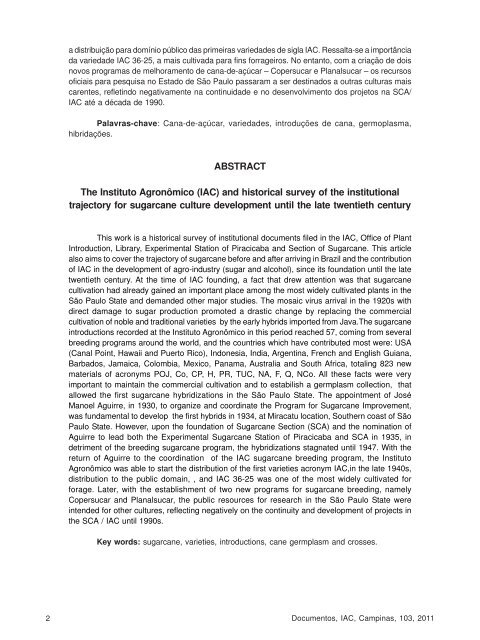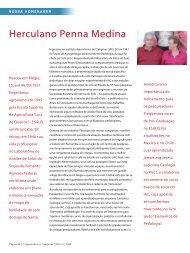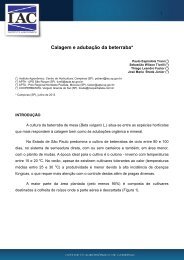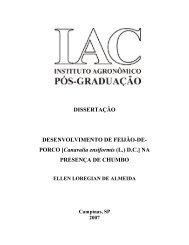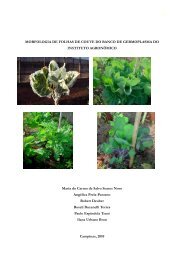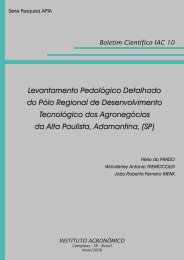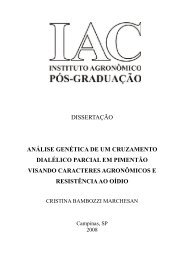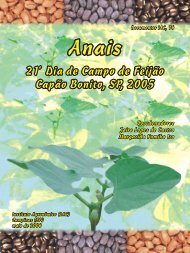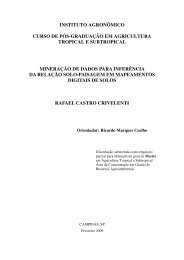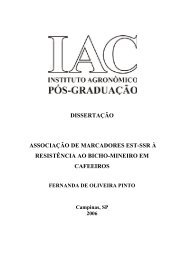Documentos IAC 103 - Governo do Estado de São Paulo
Documentos IAC 103 - Governo do Estado de São Paulo
Documentos IAC 103 - Governo do Estado de São Paulo
- No tags were found...
You also want an ePaper? Increase the reach of your titles
YUMPU automatically turns print PDFs into web optimized ePapers that Google loves.
a distribuição para <strong>do</strong>mínio público das primeiras varieda<strong>de</strong>s <strong>de</strong> sigla <strong>IAC</strong>. Ressalta-se a importânciada varieda<strong>de</strong> <strong>IAC</strong> 36-25, a mais cultivada para fins forrageiros. No entanto, com a criação <strong>de</strong> <strong>do</strong>isnovos programas <strong>de</strong> melhoramento <strong>de</strong> cana-<strong>de</strong>-açúcar – Copersucar e Planalsucar – os recursosoficiais para pesquisa no Esta<strong>do</strong> <strong>de</strong> São <strong>Paulo</strong> passaram a ser <strong>de</strong>stina<strong>do</strong>s a outras culturas maiscarentes, refletin<strong>do</strong> negativamente na continuida<strong>de</strong> e no <strong>de</strong>senvolvimento <strong>do</strong>s projetos na SCA/<strong>IAC</strong> até a década <strong>de</strong> 1990.Palavras-chave: Cana-<strong>de</strong>-açúcar, varieda<strong>de</strong>s, introduções <strong>de</strong> cana, germoplasma,hibridações.ABSTRACTThe Instituto Agronômico (<strong>IAC</strong>) and historical survey of the institutionaltrajectory for sugarcane culture <strong>de</strong>velopment until the late twentieth centuryThis work is a historical survey of institutional <strong>do</strong>cuments filed in the <strong>IAC</strong>, Office of PlantIntroduction, Library, Experimental Station of Piracicaba and Section of Sugarcane. This articlealso aims to cover the trajectory of sugarcane before and after arriving in Brazil and the contributionof <strong>IAC</strong> in the <strong>de</strong>velopment of agro-industry (sugar and alcohol), since its foundation until the latetwentieth century. At the time of <strong>IAC</strong> founding, a fact that drew attention was that sugarcanecultivation had already gained an important place among the most wi<strong>de</strong>ly cultivated plants in theSão <strong>Paulo</strong> State and <strong>de</strong>man<strong>de</strong>d other major studies. The mosaic virus arrival in the 1920s withdirect damage to sugar production promoted a drastic change by replacing the commercialcultivation of noble and traditional varieties by the early hybrids imported from Java.The sugarcaneintroductions recor<strong>de</strong>d at the Instituto Agronômico in this period reached 57, coming from severalbreeding programs around the world, and the countries which have contributed most were: USA(Canal Point, Hawaii and Puerto Rico), In<strong>do</strong>nesia, India, Argentina, French and English Guiana,Barba<strong>do</strong>s, Jamaica, Colombia, Mexico, Panama, Australia and South Africa, totaling 823 newmaterials of acronyms POJ, Co, CP, H, PR, TUC, NA, F, Q, NCo. All these facts were veryimportant to maintain the commercial cultivation and to estabilish a germplasm collection, thatallowed the first sugarcane hybridizations in the São <strong>Paulo</strong> State. The appointment of JoséManoel Aguirre, in 1930, to organize and coordinate the Program for Sugarcane Improvement,was fundamental to <strong>de</strong>velop the first hybrids in 1934, at Miracatu location, Southern coast of São<strong>Paulo</strong> State. However, upon the foundation of Sugarcane Section (SCA) and the nomination ofAguirre to lead both the Experimental Sugarcane Station of Piracicaba and SCA in 1935, in<strong>de</strong>triment of the breeding sugarcane program, the hybridizations stagnated until 1947. With thereturn of Aguirre to the coordination of the <strong>IAC</strong> sugarcane breeding program, the InstitutoAgronômico was able to start the distribution of the first varieties acronym <strong>IAC</strong>,in the late 1940s,distribution to the public <strong>do</strong>main, , and <strong>IAC</strong> 36-25 was one of the most wi<strong>de</strong>ly cultivated forforage. Later, with the establishment of two new programs for sugarcane breeding, namelyCopersucar and Planalsucar, the public resources for research in the São <strong>Paulo</strong> State wereinten<strong>de</strong>d for other cultures, reflecting negatively on the continuity and <strong>de</strong>velopment of projects inthe SCA / <strong>IAC</strong> until 1990s.Key words: sugarcane, varieties, introductions, cane germplasm and crosses.2<strong>Documentos</strong>, <strong>IAC</strong>, Campinas, <strong>103</strong>, 2011


